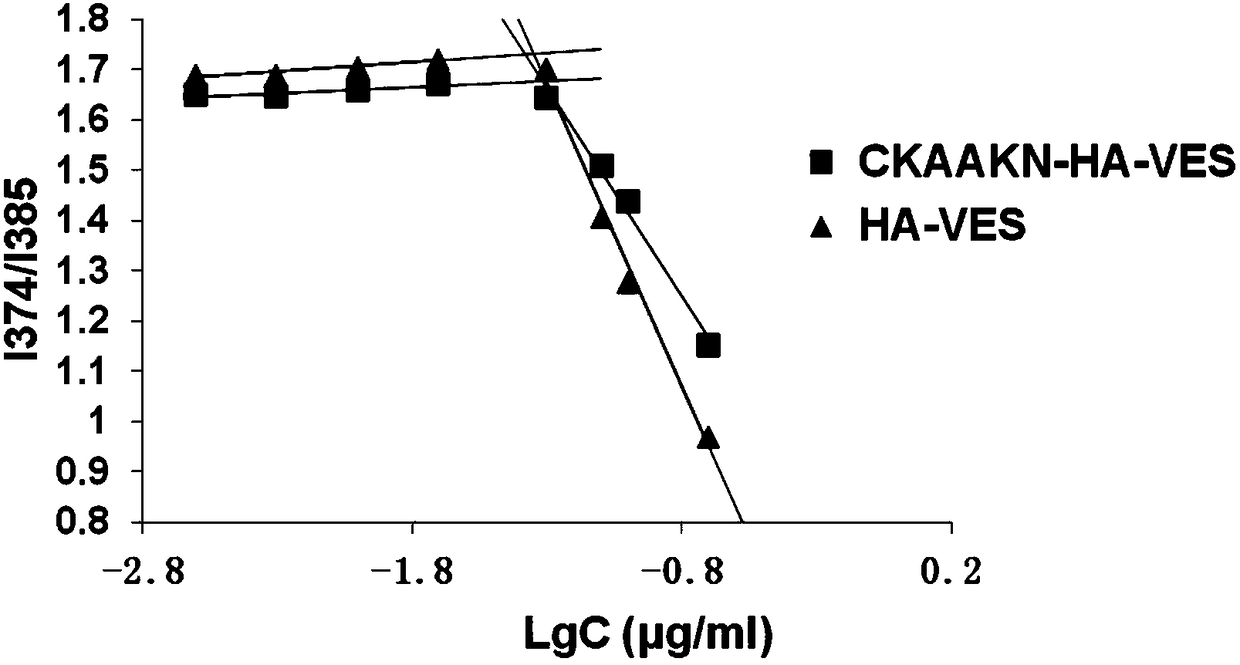Pancreatic cancer double-targeted polymer magnetic nanoparticles and preparation method and application thereof
A technology of magnetic nanoparticles and polymers, applied in the field of biomedicine, can solve the problems of weak specificity and imaging ability, poor tumor selectivity of pancreatic cancer, and large injection volume of contrast agent.
- Summary
- Abstract
- Description
- Claims
- Application Information
AI Technical Summary
Problems solved by technology
Method used
Image
Examples
Embodiment 1
[0091] Dual-targeting polymeric magnetic nanoparticles for pancreatic cancer
[0092] Ingredients: CKAAKN-hyaluronic acid-vitamin E succinate polymer micelles, iron ferric oxide magnetic nanoparticle solution, deionized water.
[0093] Preparation:
[0094] Weigh CKAAKN-hyaluronic acid-vitamin E succinate polymer micelles and dissolve them in deionized water, add oil-soluble ferric iron tetroxide magnetic nanoparticle solution under ultrasonic stirring, stir for 15-25min under ultrasonic, after 45 Rotary evaporation in a water bath at -65°C to obtain targeted polymer magnetic nanoparticles: CKAAKN-hyaluronic acid-vitamin E succinate@USPIO.
Embodiment 2
[0096] Dual-targeting polymeric magnetic nanoparticles for pancreatic cancer
[0097] Ingredients: 40 mg of CKAAKN-hyaluronic acid-vitamin E succinate polymer micelles, 50 μL of ferroferric oxide magnetic nanoparticle solution, and 16 ml of deionized water.
[0098] Preparation:
[0099] Weigh CKAAKN-hyaluronic acid-vitamin E succinate polymer micelles and dissolve them in deionized water, add oil-soluble ferroferric oxide magnetic nanoparticle solution under ultrasonic stirring, stir for 15 minutes under ultrasonic, and place in a water bath at 45°C Rotary evaporation to obtain targeted polymer magnetic nanoparticles: CKAAKN-hyaluronic acid-vitamin E succinate@USPIO.
Embodiment 3
[0101] Dual-targeting polymeric magnetic nanoparticles for pancreatic cancer
[0102] Ingredients: 60 mg of CKAAKN-hyaluronic acid-vitamin E succinate polymer micelles, 150 μL of ferroferric oxide magnetic nanoparticle solution, and 24 ml of deionized water.
[0103] Preparation:
[0104] Weigh CKAAKN-hyaluronic acid-vitamin E succinate polymer micelles and dissolve them in deionized water, add oil-soluble ferric iron tetroxide magnetic nanoparticle solution under ultrasonic stirring, stir under ultrasonic for 25min, and place in a 65°C water bath Rotary evaporation to obtain targeted polymer magnetic nanoparticles: CKAAKN-hyaluronic acid-vitamin E succinate@USPIO.
PUM
| Property | Measurement | Unit |
|---|---|---|
| Concentration | aaaaa | aaaaa |
Abstract
Description
Claims
Application Information
 Login to View More
Login to View More - Generate Ideas
- Intellectual Property
- Life Sciences
- Materials
- Tech Scout
- Unparalleled Data Quality
- Higher Quality Content
- 60% Fewer Hallucinations
Browse by: Latest US Patents, China's latest patents, Technical Efficacy Thesaurus, Application Domain, Technology Topic, Popular Technical Reports.
© 2025 PatSnap. All rights reserved.Legal|Privacy policy|Modern Slavery Act Transparency Statement|Sitemap|About US| Contact US: help@patsnap.com



